Managing WordPress Updates with InfiniteWP
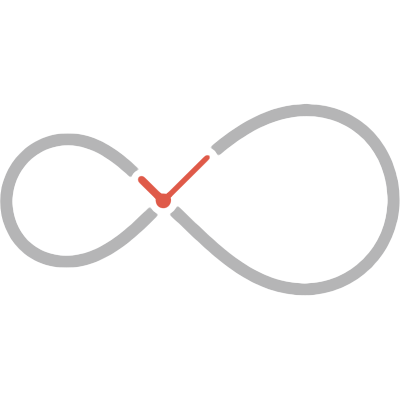
Key Takeaways
- InfiniteWP is an administration panel that simplifies the management of multiple WordPress websites by allowing users to conduct plugin, platform, and theme updates from a central location. It also provides a backup feature for added security during updates.
- InfiniteWP can be installed via a WordPress Plugin, cPanel, or manual installation, making it a versatile solution for different hosting options. Once installed, users can easily connect their WordPress websites to the InfiniteWP admin panel, allowing for efficient updates and backups.
- The tool offers customization options including group management of sites, scheduled updates, and security settings. InfiniteWP also provides premium add-ons for more advanced features such as scheduled backups, clone WordPress, uptime monitoring, and client reporting.

This article is part of a series created in partnership with SiteGround. Thank you for supporting the partners that make SitePoint possible.
InfiniteWP is an administration panel that provides almost effortless management of multiple WordPress websites.
Do you administer more than one WordPress website for your organization? Do you host WordPress websites, or are you a developer who maintains sites for clients? This is the perfect tool for you, if so!
What Problems Does It Solve?
- Plugin Updates – Keeping track of the endless security updates, bug fixes, and new-feature updates of every plugin deployed on your WordPress sites can be extremely tedious, especially if you have multiple sites to manage. These plugin updates can be done with a click of a button from InfiniteWP.
- Platform Updates – In addition, updates to the WordPress platform can be conducted from this central location as well. Are you familiar with the changes in the new version? If so, you can easily update all of your sites to it.
- Theme Updates – What about updates to themes (or parent themes) that have been used to build the UI of your websites? Those, too, can be updated all from the admin panel, whether you’re using the same themes on multiple sites, or all unique ones. If it is updatable within WordPress, it will be updatable using InfiniteWP.
- Backups – In addition to all of the update features, InfiniteWP also allows you to take backups of your attached websites, the files and database of them. This enables you to update with confidence. Have some untested plugins to update? Back the site up first!
Setting up InfiniteWP
Installation and setup can be done in one of three ways:
This mix of options means that whether you’re on a shared host with a cPanel, on a VPS, or any other hosting option, it’s likely that you’ll be able to find a solution that meets your needs, and deploy InfiniteWP to manage your WordPress sites!
Setting up a Site on InfiniteWP
Once you’ve installed InfiniteWP and logged into the admin panel successfully, you’ll encounter the dashboard screen.
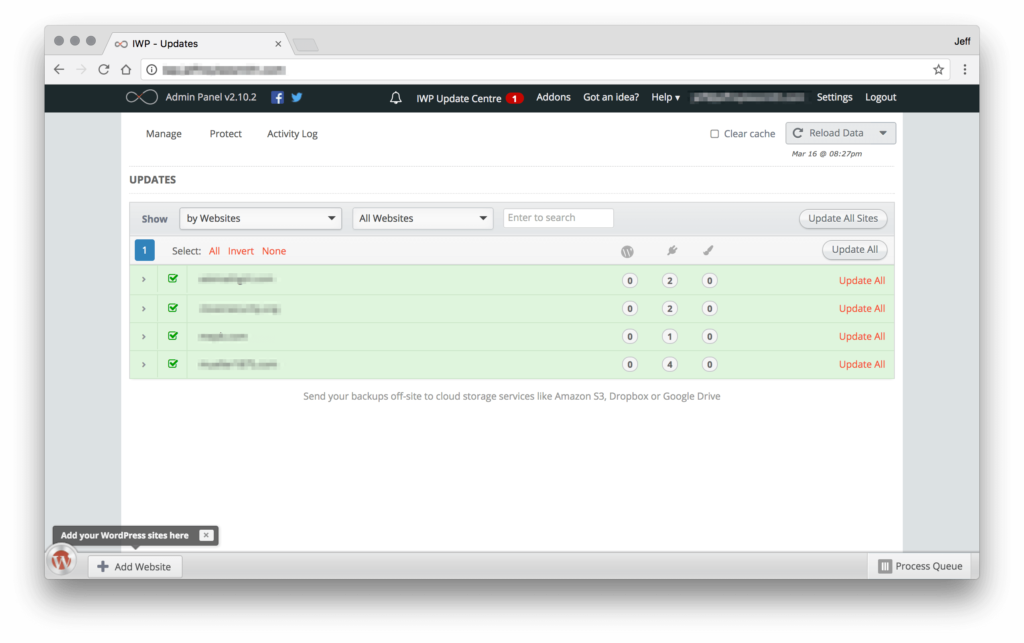
Your next step in connecting a website to your InfiniteWP dashboard will be to add the InfiniteWP plugin to the WordPress website you wish to manage with InfiniteWP. You can do this easily by going to your Plugins menu, choosing to Add a Plugin, and searching for InfiniteWP.
Once this is done, and the plugin activated, you will see an alert panel in WordPress conveying important InfiniteWP information to you.
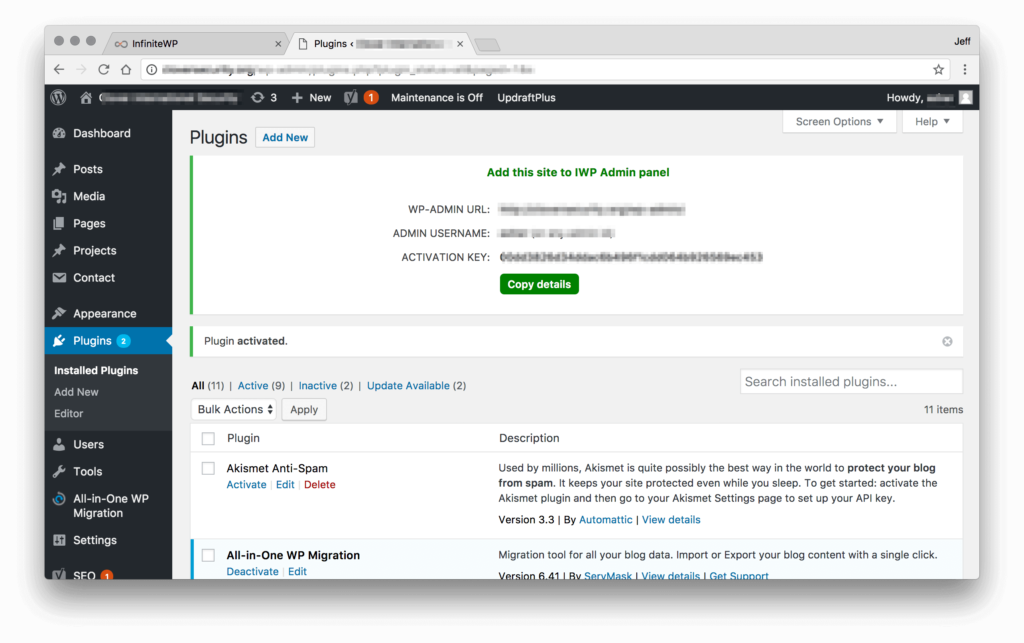
Now, head back to the InfiniteWP panel and click the “Add Website” button in the bottom left. This should bring you to a new website form.
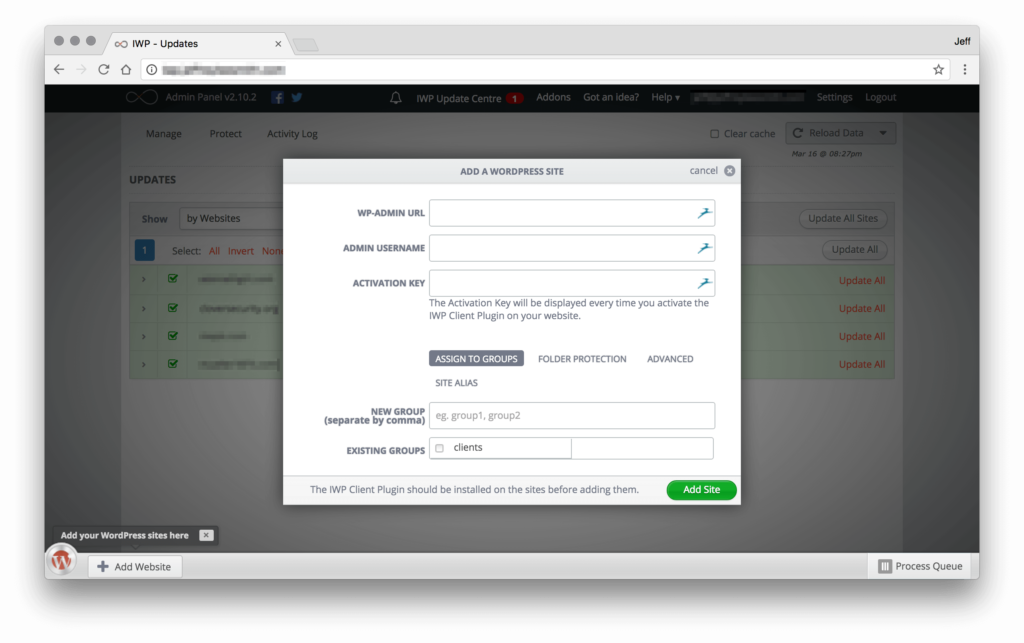
You can paste the website information into this form. And now your WordPress website is connected to the admin panel!
Checking the connection is a breeze. You can click the WordPress icon in the bottom left to pull out the Websites Drawer. This will contain a list of WordPress websites you’ve linked to the InfiniteWP admin panel.
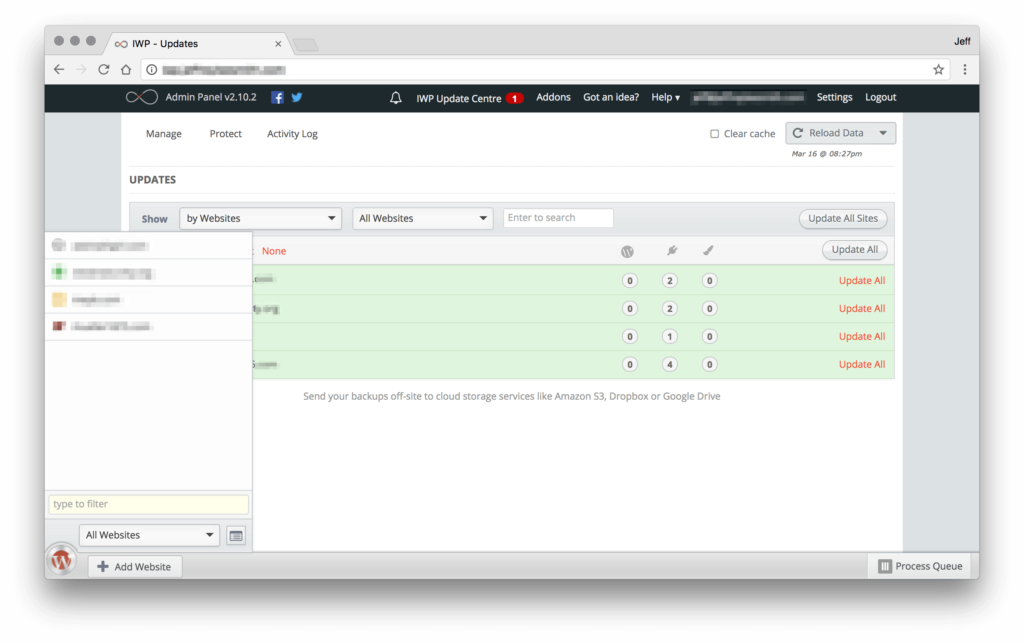
Hovering over the name of one of your sites in the list will pop out an information panel next to it. Here, you’ll see several links. One lets you go straight to the WordPress admin panel for that site, one to start a post, one to do updates for that site, etc. You can also choose “Reload Data”, and see the progress of that operation in the Process Queue in the bottom right of the admin panel, as well as whether it succeeds or fails. If it succeeds, all is working well!
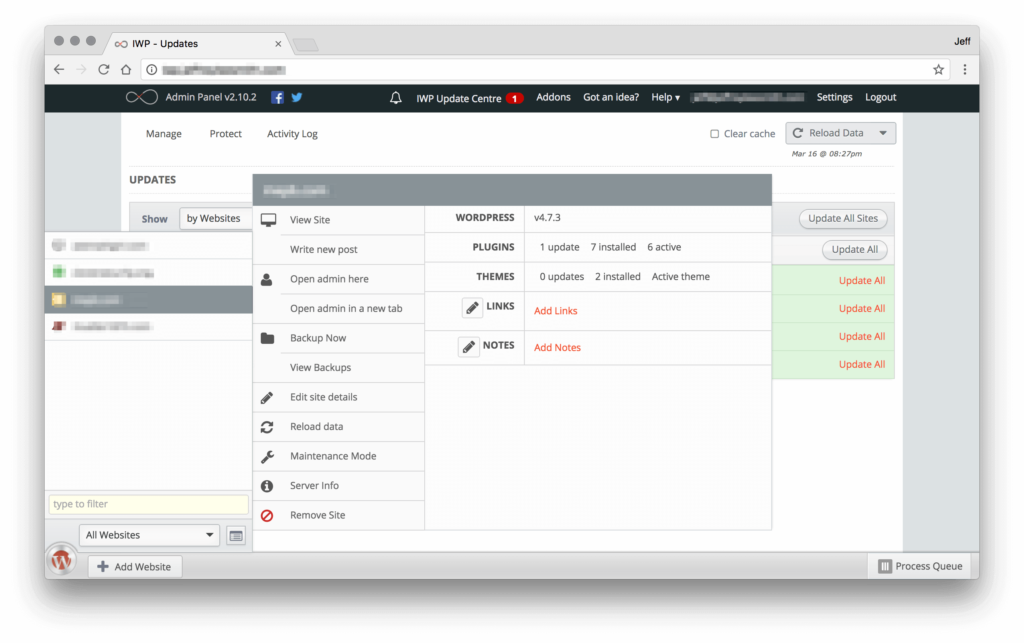
Running Updates or Backups
Running updates and backups is a breeze with InfiniteWP. You have options to run specific updates on specific sites, to run them as groups, or to run all available updates.
Specific updates
Particular updates can be run from the admin panel’s dashboard. You’ll see a list of your websites which have updates which need your attention. If you click one, it will break down into a list of necessary updates.
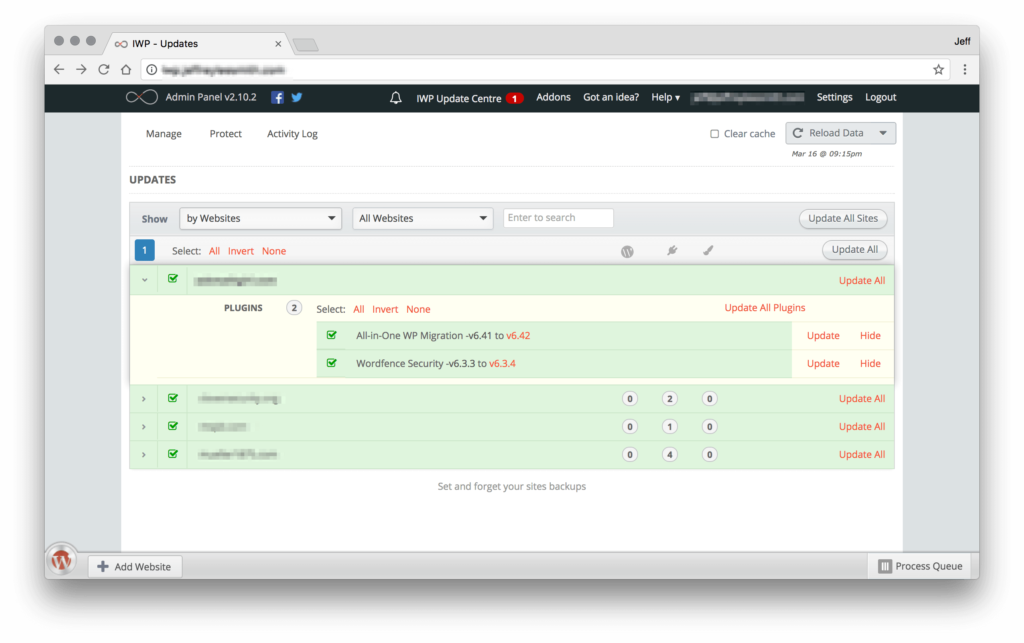
This makes it easy to cherry-pick particular updates from the list and do only those updates for the selected site, one at a time.
Batch updates
You can also do updates in a batch – for example, if you wish to simply update everything that can be updated on every site, you can just hit “Update All Sites” on the dashboard, and InfiniteWP will attempt to update the platform, plugins, and themes of every connected site and report on its success or failure in the Process Queue.
Groups
Website can also be added to Groups in order to further segment your managed sites. This can be done by going to the Drawer, hovering over your site, and choosing “Edit Site Details”. On this screen, you will see an Assign to Groups option.
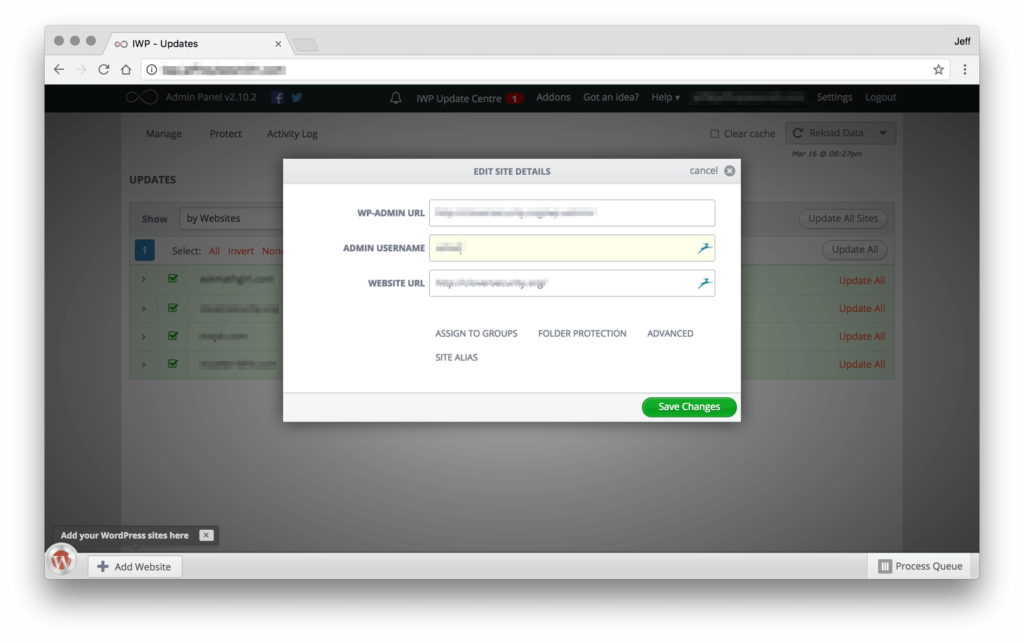
After you have sites assigned to Groups, from the dashboard you can pick to show specific Groups rather than “All Websites” – and then use “Update All” to update all of the websites in that particular group.
There are many reasons you might wish to have Groups – here are a few ideas:
- Production and Staging Groups. If your website management dictates that you have staging environments for each of your sites, you might wish to do batch updates to the staging environments first, to ensure there are no compatibility or other issues with the updates, before then proceeding to deploy the same updates to the production sites.
- Project type is another Group that might prove useful. Differentiating between your own projects and paying clients, for example, might be useful.
- Another useful Group could be client types. You might have monthly maintenance clients, quarterly maintenance clients, clients who only want critical security updates, etc. The possibilities are endless!
Settings
InfiniteWP has several different features that can be customized in the Settings panel.
- Account settings allow you to change the administrator email, and setup email notifications (if a cron job is set up)
- App settings contain things like limits on requests, logging, and basic app level requests
- Security settings allow you to lock down InfiniteWP to allow access only from certain IPs, as well as a few other options.
- Email settings allow you to set up an email provider for alerts and messages from the admin panel.
- Cron settings allow you to set up cron jobs to run updates on a schedule
- And lastly, you can also update the InfiniteWP app itself from the App Update settings
Conclusions
When you are on the hunt for an easy way to manage multiple WordPress installations, take a look at InfiniteWP. It will save you a considerable amount of time when you do updates in batches, and the more sites you manage, the more valuable it becomes. The only thing you have to invest is a little setup time at the start, and you’ll be ready to start being more efficient with your WordPress multi-site management!
Alternatively, you can let your hosting provider take care of WordPress maintenance. SiteGround offers automatic WordPress core and plugin updates, and automatic daily backups. SiteGround also makes backups before each automatic update and runs checks afterwards so that you can easily restore to the latest working version if something goes wrong.
Frequently Asked Questions about Managing WordPress Updates with InfiniteWP
How does InfiniteWP compare to other WordPress management tools?
InfiniteWP is a self-hosted, multiple WordPress site management solution. It stands out from other tools due to its one-click updates, backup and restore options, and the ability to manage all your WordPress sites from a single dashboard. Unlike other tools, InfiniteWP is self-hosted, meaning you have complete control over your data and privacy.
Is InfiniteWP free to use?
Yes, InfiniteWP offers a free version that includes basic features such as one-click updates, backup and restore, and managing multiple sites. However, for more advanced features like scheduled backups, clone WordPress, uptime monitoring, and client reporting, you would need to purchase their premium add-ons.
How do I install the InfiniteWP admin panel?
To install the InfiniteWP admin panel, you need to download it from the official website. Once downloaded, upload it to your server using an FTP client. After uploading, visit the uploaded URL and follow the on-screen instructions to complete the installation.
Can I manage multiple WordPress sites with InfiniteWP?
Yes, InfiniteWP is designed to manage multiple WordPress sites from a single dashboard. This feature is particularly useful for agencies and developers who manage multiple client websites.
How secure is InfiniteWP?
InfiniteWP is a self-hosted solution, meaning all your data remains on your server. It uses secure SSL encryption for data transmission. Moreover, it doesn’t store your WordPress login credentials, adding an extra layer of security.
Can I schedule backups with InfiniteWP?
Yes, but this feature is available only in the premium version. With the premium version, you can schedule backups, choose where to store them, and even set up automatic updates.
Does InfiniteWP offer client reports?
Yes, InfiniteWP offers client reports as a premium add-on. This feature allows you to generate detailed reports about updates, backups, and other activities for your clients.
Can I clone my WordPress site with InfiniteWP?
Yes, InfiniteWP offers a clone feature as a premium add-on. This feature allows you to clone your WordPress site to a new domain or server.
Does InfiniteWP offer uptime monitoring?
Yes, InfiniteWP offers uptime monitoring as a premium add-on. This feature notifies you if your website goes down, helping you to quickly address the issue.
Can I manage my WordPress plugins and themes with InfiniteWP?
Yes, with InfiniteWP, you can manage all your plugins and themes from a single dashboard. You can activate, deactivate, and update plugins and themes across all your WordPress sites with a single click.
Jeff works for a startup as a technical writer, does contract writing and web development, and loves tinkering with new projects and ideas. In addition to being glued to a computer for a good part of his day, Jeff is also a husband, father, tech nerd, book nerd, and gamer.


